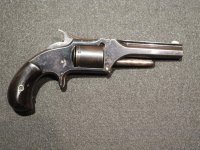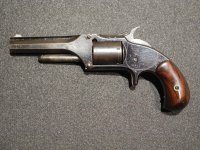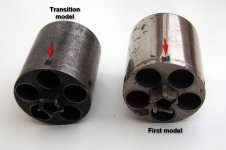You are using an out of date browser. It may not display this or other websites correctly.
You should upgrade or use an alternative browser.
You should upgrade or use an alternative browser.
Model 1 1/2 Transition
- Thread starter danalex
- Start date
Register to hide this ad
opoefc
US Veteran
Value ? Hard to say, they don't show up often enough to see a price paid trend, but I would guess around $1,750 to $2,000 range in the USA. I don't have a clue what you would have to pay in France. I would presume they are much more scarce in France, but so are S&W collectors that would seek it., so that might make it more of a bargain in France. Ed.
Last edited:
danalex
Member
Relatively rare also in France but cheaper than in the United States.
About 1000 €
About 1000 €
Pardon my ignorance but what is a 1 1/2 transition model????? I am just getting into the pre hand ejector guns and would like to learn.
That is in incredible condition! What a great find. I have been amazed at the condition of some of the 19th century American firearms that turn up in Europe. Perhaps folks on your continent took better care of them. Congratulations.
This old thread is a good summary of the 1 1/2 Transition Model
http://smith-wessonforum.com/s-w-an...tion-model-revolver.html?highlight=transition
http://smith-wessonforum.com/s-w-an...tion-model-revolver.html?highlight=transition
Skeetr57
Member
James: The term "Transition Model" is a misnomer, as these guns were produced after the second issue M 1 1/2 guns were in production. After the 2nd issue was in production, S&W discovered that they had a large quantity of barrels and cylinders for the 1st issue on hand, and rather than scrap them, they made up sufficient modified 2nd issue frames to use up the old parts.
\\\
\\\
Ah, now I remember. It came back to me after reading the other linked thread. It's amazing how much I seem to forget these days soon after I learn it. As a matter of fact I was just saying the other day......
danalex
Member
For me S & W had only barrels in stock, the cylinders is not interchangeable with the Model 1 1/2
danalex
Member
Transition ou Mongrel !
mmaher94087
Member
"For me S & W had only barrels in stock, the cylinders is not interchangeable with the Model 1 1/2." This is what I remember also.
Who's jsr III, I forget?
Who's jsr III, I forget?
There were only 650 of these transition models produced in February and March 1868. 400 were shipped to France, 200 to Japan, and only 50 stayed in the U.S.
The 9th edition of the Flayderman's guide rates this model from $1,750 in very good condition to $3,750 in excellent condition.
One of these, retaining 30 % of its original blue finish and some minor pitting on the cylinder was sold for $2,500 in December 2012 by Rock Island Auction Company. The initial estimation was $3,500-$6,500.
The 9th edition of the Flayderman's guide rates this model from $1,750 in very good condition to $3,750 in excellent condition.
One of these, retaining 30 % of its original blue finish and some minor pitting on the cylinder was sold for $2,500 in December 2012 by Rock Island Auction Company. The initial estimation was $3,500-$6,500.
PhullOtto
US Veteran
Serial # 111222 Model 1 1/2 help please.
Please help me date and value a recent find:
Model 1 1/2 with serial number 111222 and cylinder lettering H H A to match the letters on the Hinged section.
Nicely nickel finished with light wear - discoloration on one of the fluted cylinder areas and what I think of as better than average retention of the color/case on Hammer and the Trigger with proper knurling on the tip.
Please help me date and value a recent find:
Model 1 1/2 with serial number 111222 and cylinder lettering H H A to match the letters on the Hinged section.
Nicely nickel finished with light wear - discoloration on one of the fluted cylinder areas and what I think of as better than average retention of the color/case on Hammer and the Trigger with proper knurling on the tip.
Attachments
For me S & W had only barrels in stock, the cylinders is not interchangeable with the Model 1 1/2
The cylinder fits just fine from either model, no difference in the design other than the flutes. Remember that parts were hand-fit and there may well have been enough difference that some parts might not work on another gun. I can change out the cylinders between my Model 1 1/2 1st and 2nd and they index perfectly.
Forgot to mention that there is no capital M in mongrel.
Last edited:
Please help me date and value a recent find . . . Model 1 1/2 with serial number 111222 and cylinder lettering H H A to match the letters on the Hinged section.
The Model 1 1/2, 2nd Issue was made from 1868 to 1875 in serial number range 26,301 to 127,000. Your revolver would have been made very late in production and could have shipped in 1874 - 1875 or maybe later. Valuation is often difficult on these rimfire revolvers since demand is not very high. I just sold 4 in good working condition and some wear on the finish - all for under $300 at auction. Without images, it is impossible to grade condition, but in reality, they are selling for $200 to $400 range for functioning guns with good finish.
mmaher94087
Member
The cylinders of the 1 1/2, 1st and 2nd Models are not interchangeable. Yes, they will fit, revolve and lock in battery but the cylinder charge holes will not align with the barrel and hammer. The 5-shot cylinder of the 1st Model has the cylinder stop (bolt) on the bottom frame whereas, the 2nd Model has the stop on the top. The Transition cylinder (non-fluted) has a cylinder unique to the Transition in that the 2nd model frame used on this revolver has the cylinder stop on the top. The Transition cylinder has the cylinder stop notches cut around its perimeter like the fluted cylinder of the 2nd Model.
And that is why they are worth so much! I can only see the value of the transitional or factory named mongrel 1 1/2's going up. I'm following the market daily and the S&W Double Action Top breaks are going nuts! I just saw a "NO finish" 3rd model 38 just sell for $380 on gunbroker. Over $500 with finish. This spike seems to be driven by the action shooters in my opinion but this certainly is not a bad thing. Is it a market governing impact? I don't know. In the long run I suppose it would be. After all they are antiques and only so many were manufactured and only a limited percentage actually survived to this century. Lots of those are not functional or are in pieces or relics. The 1 1/2's in 32 rimfire are likely lagging behind in Market value only because there are no viable rounds "readily available" for them to be put back into action or I'm sure they too would be spiking. That to may soon change. I've been communicating with a vendor that wants to bring back the .41 rimfire and asked me for some inside scoop from my books info.
So if they succeed with the .41 rimfire perhaps they will invest in the .32 rimfire as well. I think the other governing factor is forums like this one that spread information. I think we underestimate ourselves and what we do here folks! We also have a significant impact on the market and market interest!
So if they succeed with the .41 rimfire perhaps they will invest in the .32 rimfire as well. I think the other governing factor is forums like this one that spread information. I think we underestimate ourselves and what we do here folks! We also have a significant impact on the market and market interest!
The cylinders of the 1 1/2, 1st and 2nd Models are not interchangeable. Yes, they will fit, revolve and lock in battery but the cylinder charge holes will not align with the barrel and hammer. The 5-shot cylinder of the 1st Model has the cylinder stop (bolt) on the bottom frame whereas, the 2nd Model has the stop on the top. The Transition cylinder (non-fluted) has a cylinder unique to the Transition in that the 2nd model frame used on this revolver has the cylinder stop on the top. The Transition cylinder has the cylinder stop notches cut around its perimeter like the fluted cylinder of the 2nd Model.
I confirm. See below the photo of the transition model cylinder compared to the first model's. You will see the difference in the placement of the cylinder notches.
I will add that although the frame of the transition model is a second model frame, the second model barrel won't lock on the transition model frame, because the part where it locks is much wider on this last frame. See also the photo below.
These differences explain why, fortunately, it is almost impossible to make a fake transition by mixing first and second model parts !
Attachments
. . . See below the photo of the transition model cylinder compared to the first model's. You will see the difference in the placement of the cylinder notches . . .
I apologize for the error in my previous post. I pulled my Model 1 1/2s and found two things. The cylinders interchange perfectly and the cylinder advances on every pull of the hammer, BUT I did not notice that the chambers are off by half notch per pull, aligning the striker with the web of the cylinder instead of the chamber. I guess I advanced the often stated comments that the barrel AND cylinder would interchange. I have read that comment many times. Technically, the statement is accurate, except for the small fact that the round would not fire.



![20190406_115913[1].jpg](https://cdn.smith-wessonforum.com/attachments/319/319399-ee3b0e8a7331b8c3192aa5beee149090.jpg?hash=IkLxh5p66K)
![20190406_115857[1].jpg](https://cdn.smith-wessonforum.com/attachments/319/319401-9f689a333f5509481d93febe751aa3e5.jpg?hash=Zwoq3Gd4Bh)
![20190406_115905[1].jpg](https://cdn.smith-wessonforum.com/attachments/319/319402-3f50563d06e2151fb404dc054c8d9c49.jpg?hash=zE1-bAqqNI)
![20190406_120114[1].jpg](https://cdn.smith-wessonforum.com/attachments/319/319400-0a119df68beb11aa2d2f896a5f2360f9.jpg?hash=dZCS-PyWth)
![20190406_120124[1].jpg](https://cdn.smith-wessonforum.com/attachments/319/319403-0133fe1ade070143e9aa7d30ca13702a.jpg?hash=gRwQ5-k4xm)

